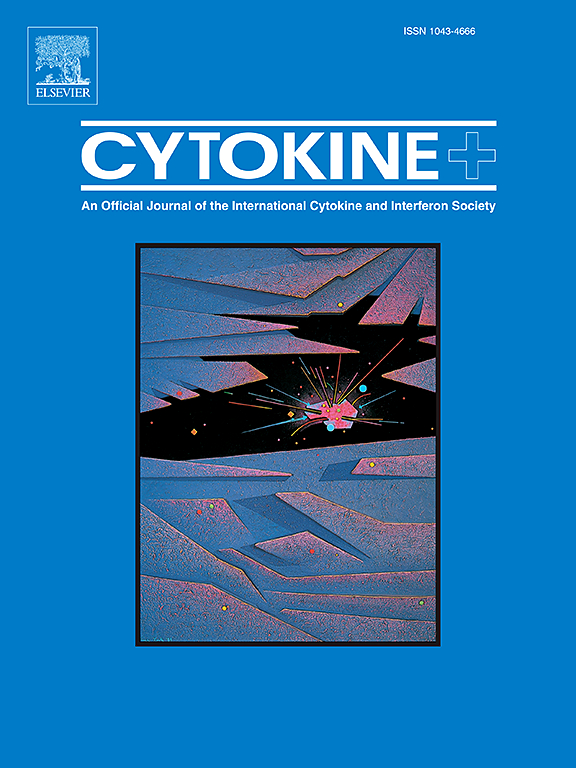IL-17A, IL-23R, FCGR3A are associated with neuropsychiatric systemic lupus erythematosus susceptibility in pediatric patients with lupus nephritis
IF 3.7
3区 医学
Q2 BIOCHEMISTRY & MOLECULAR BIOLOGY
引用次数: 0
Abstract
Objective
To comprehensively investigate the impact of candidate loci on the susceptibility to neuropsychiatric systemic lupus erythematosus (NPSLE) in a cohort of Chinese children with lupus nephritis (LN).
Methods
This case-control study included sixty-two patients. And the case group consisted of 12 LN patients appearing NPSLE, while the control group consisted of 50 LN patients. A total of fifty-four single nucleotide polymorphisms (SNPs) across twenty genes were genotyped using the Agena Bioscience MassArray iPLEX platform. The associations between susceptibility to NPSLE and candidate SNPs were assessed using SNPStats online software. We evaluated the influence of candidate SNPs on the risk of NPSLE through odds ratios (OR) and 95 % confidence intervals (CI). Additionally, linkage disequilibrium (LD) and coefficient (D′ and r2) for haplotypes and their frequencies were performed using the genetic statistical online software SHEsis.
Results
Three significant SNPs were identified: IL17RA rs2895332, IL23R rs10889677, and FCGR3A rs396991. AA genotype of FCGR3A rs396991, GG genotype of IL17RA rs2895332 and AA genotype of IL23R rs10889677 exhibited a decreased risk of NPSLE compared to CA and CC genotypes, GA and AA genotypes, and CA and CC genotypes (rs396991 AA vs. CA-CC, OR 5.00, 95 %CI 0.99–25.17, P = 0.029; rs2895332 GG vs. GA-AA, OR 7.83, 95 %CI 1.47–41.79, P = 0.017; rs10889677 AA vs. CA-CC, OR 4.50, 95 %CI 1.08–18.69, P = 0.027). Furthermore, the haplotype A-T-G (STAT4 rs13426947, rs1551443 and rs3024866) appeared to confer protection against the development of NPSLE. The multivariate logistic regression analysis indicated that two specific SNPs were significantly associated with an increased risk of NPSLE: [FCGR3A rs396991 (OR = 6.444, 95 %CI = 1.1–37.736, P = 0.039), IL17RA rs2895332 (OR = 0.128, 95 %CI = 0.017–0.963, P = 0.046)]. Notably, the RegulomeDB score of them reached 1 f. Using HaploReg, these loci were in strong LD (r2>0.8) with several SNPs.
Conclusion
Our findings indicate that the polymorphisms IL17RA rs2895332, IL23R rs10889677, and FCGR3A rs396991 are significantly associated with the risk of NPSLE in childhood-onset LN.
IL-17A、IL-23R、FCGR3A与小儿狼疮性肾炎患者神经精神系统红斑狼疮易感性相关
目的全面探讨候选基因座对中国狼疮性肾炎(LN)患儿神经精神系统性红斑狼疮(NPSLE)易感性的影响。方法本研究纳入62例患者。病例组为12例出现NPSLE的LN患者,对照组为50例LN患者。使用Agena Bioscience MassArray iPLEX平台对20个基因的54个单核苷酸多态性(snp)进行基因分型。使用SNPStats在线软件评估NPSLE易感性与候选snp之间的关系。我们通过比值比(OR)和95%置信区间(CI)评估候选snp对NPSLE风险的影响。此外,利用遗传统计在线软件SHEsis对单倍型及其频率进行连锁不平衡(LD)、系数(D '和r2)分析。结果鉴定出3个显著snp: IL17RA rs2895332、IL23R rs10889677和FCGR3A rs396991。FCGR3A rs396991的AA基因型、IL17RA rs2895332的GG基因型和IL23R rs10889677的AA基因型与CA和CC基因型、GA和AA基因型、CA和CC基因型相比,NPSLE的发病风险降低(rs396991 AA vs CA-CC, OR 5.00, 95% CI 0.99 ~ 25.17, P = 0.029;GG vs. GA-AA, OR 7.83, 95% CI 1.47 ~ 41.79, P = 0.017;AA vs CA-CC, OR 4.50, 95% CI 1.08 ~ 18.69, P = 0.027)。此外,单倍型A-T-G (STAT4 rs13426947, rs1551443和rs3024866)似乎对NPSLE的发展具有保护作用。多因素logistic回归分析显示,两个特异性snp与NPSLE风险增加显著相关:FCGR3A rs396991 (OR = 6.444, 95% CI = 1.1 ~ 37.736, P = 0.039)、IL17RA rs2895332 (OR = 0.128, 95% CI = 0.017 ~ 0.963, P = 0.046)。值得注意的是,它们的RegulomeDB得分达到了1 f。使用HaploReg,这些位点处于强LD (r2>0.8),有几个snp。结论IL17RA rs2895332、IL23R rs10889677、FCGR3A rs396991基因多态性与儿童期LN NPSLE发生风险显著相关。
本文章由计算机程序翻译,如有差异,请以英文原文为准。
求助全文
约1分钟内获得全文
求助全文
来源期刊

Cytokine
医学-免疫学
CiteScore
7.60
自引率
2.60%
发文量
262
审稿时长
48 days
期刊介绍:
The journal Cytokine has an open access mirror journal Cytokine: X, sharing the same aims and scope, editorial team, submission system and rigorous peer review.
* Devoted exclusively to the study of the molecular biology, genetics, biochemistry, immunology, genome-wide association studies, pathobiology, diagnostic and clinical applications of all known interleukins, hematopoietic factors, growth factors, cytotoxins, interferons, new cytokines, and chemokines, Cytokine provides comprehensive coverage of cytokines and their mechanisms of actions, 12 times a year by publishing original high quality refereed scientific papers from prominent investigators in both the academic and industrial sectors.
We will publish 3 major types of manuscripts:
1) Original manuscripts describing research results.
2) Basic and clinical reviews describing cytokine actions and regulation.
3) Short commentaries/perspectives on recently published aspects of cytokines, pathogenesis and clinical results.
 求助内容:
求助内容: 应助结果提醒方式:
应助结果提醒方式:


